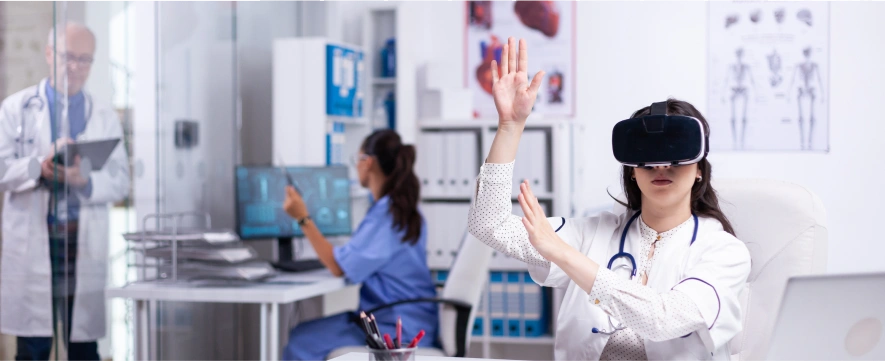Virtual Reality in Surgery Training | Domain Potential Overview
Virtual Reality (VR) brings a completely new wave of innovation within the medical field. Virtual Reality in surgery training is one of the most common VR applications in 2023.
Surgical training hasn’t changed a lot over the last 100 years. Residents observe how experienced surgeons work so then they can perform surgeries on their own. But Vice President of Global Education Solutions for Johnson & Johnson Medical Devices, Sandra Humbles reports that this model no longer services as well as it has been for years. Technology has accelerated the pace of surgical training and innovation, so there is much more for surgeons to learn than ever before.
 4.64 Billion
4.64 Billion
The North American medical AR and VR industry is suggested to reach 4.64 billion U.S. dollars by 2025.
The key global companies of Virtual Reality in Medicine and surgery include CAE, Immersivetouch, Mentice, Mimic Technologies, Simbionix, Surgical Theather, Virtamed, VR Simulators, Zspace, etc.
 34.9%
34.9%
Studies report that the global VR medical market will grow at a CAGR of 34.9% from 2023 to 2030.
VR Surgery Training | Uses
-
VR Surgery Training | Uses
Virtual Reality allows surgeons to practice in highly realistic, immersive virtual ecosystems that accurately mimic real-life procedures. Using VR in surgery training allows residents to practice just like in real life from the first year instead of waiting for three years to start getting practice. This, in turn, improves the quality of care, increases the chances of successful procedures, and speeds up the training process without sacrificing quality.
-
Procedural Variety and Complexity
There are conditions that are far too rare and may demand years of research before surgeons will be able to perform them. For example, conjoined twins. Virtual reality surgery simulation allows surgeons to experience different scenarios and develop a comprehensive approach for almost any unexpected situation.
-
Mistake-Friendly Environments
Virtual reality in surgery training allows residents to practice and make mistakes safely without damaging someone’s life. The research shows that Virtual Reality surgery training reduces up to 50% of surgical errors thanks to advanced practice. Trainees in VR ecosystems are free to try different approaches, methods, and teams to find what works for each surgery best.
-
Remote and Collaborative Learning
Medical training Virtual Reality also makes it easy for surgeons to collaborate with colleagues when needed. This reduces the need to attract a high amount of in-house staff to train future doctors; they can just stay connected online. In addition, VR allows for virtual team-based surgical procedures, which has been shown to significantly enhance knowledge exchange as well as collaboration across clinics.
-
Long-Term Cost-Effectiveness
The cost of VR technology implementation into medical setup could look intimidating (it usually takes $25,000-$250,000 combined with headsets for a well-rounded app). But this technology is worth the investment in the long term. For example, there are many resources used in surgery training sessions, like medical cadavers and operating tools. Most of these tools are single-use or suffer from supply bottlenecks, which is an issue that won’t be faced with surgical Virtual Reality thanks to its reusable, scalable, and shareable tools.
-
Objective Performance Measurement
Among all trending healthcare app ideas, virtual reality in surgery training enables effective feedback on a trainee’s performance since it allows tracking accuracy and analyzing data, including speed, movement precision, as well as overall training efficiency. This helps to greatly evaluate their skills and find improvement areas via personalized training plans.
Need help with planning the details of your VR Surgery Training App?
Why Do You Need Virtual Reality for Surgery Training?
-
Hyper-Realistic Simulations
- Create custom VR surgical simulation for specific procedures;
- Mistake-friendly ecosystem allows for low-stakes VR surgical training to gain confidence;
- Quality and immersive simulations are perfect for active surgeons to train in new methods and techniques.
-
Improved Collaboration
- Residents can collaborate on a single procedure in VR training rooms;
- Guidance and real-time help measures students’ accuracy and efficiency;
- 3D teleconferencing allows residents to broadcast live procedures and offer guidance on the go.
-
Remote Learning Opportunities
- Residents can better visualize complex procedures from all across the globe;
- Make medical learning available for non-urban, low-resource areas for healthcare accessibility;
- Fully immersive surgical experience even when in-person training isn’t possible.
Benefits of VR Surgery Training

Cost
Clinics and institutions using virtual reality in surgery training significantly reduce costs by creating a virtual operating room that allows surgeons to train skills from anywhere. Using virtual Reality also reduces the costs of traveling, cadavers as well as shipment of robotics and/or comprehensive medical devices.
Time
The amount it usually takes to set up a room for in-person surgical training could be invested in more valuable and profitable tasks. In addition, medical teams are usually created for effective training, especially when we talk about specific cases that require extra expertise or more than one team is involved. That is why virtual Reality gives anyone access to content from all across the world while taking only a few minutes to set up the room or add a team.
Experience
Virtual Reality has gone a long way in terms of improving visual quality. Large companies working with VR technologies, like Osso VR, now offer the largest medical illustration team globally with huge experience in different companies in film, games, and technology. This offers hyper-realistic imagery that develops seamless and immersive training at each step of the procedure.
Flexibility
Not every clinic and institution has teams experienced enough to help residents develop needed skills. That is why VR is highly used among those organizations as an easy, affordable, and fast way to attract skilled surgeons to train new ones. VR doesn’t require all surgeons to present in the room in person, so both medical teams and tutors can jump into the virtual operating room from anywhere using hardware.
Repeatability
The best way to train and gain new knowledge is through “spaced repetition.” In modern training realities, residents will have 1-2 procedures per day, and most of them will be the same, so there won’t be any way to train something new or specific. Nevertheless, virtual reality for medical training allows doctors to train repeatedly over a longer period of time and with wider options of available procedures.Repeatability
AR vs. VR: The Difference
Now you know how VR is used in surgery training, but what about the AR concept? Augmented Reality (AR) is similar to virtual Reality and can also benefit the medical field in different ways. AR refers to the technology that superimposes computer-generated interfaces, imagery, or/and simulations over the real world.
Let’s take as an example one of the most popular mobile games – Pokemon Go. The camera captures the world in front of the person, and the Pokemon Go application can superimpose Pokemon into the ecosystem. The user is able to interact with this digital ecosystem via the phone. Google Maps can also be taken as a bright example since the technology superimposes a digital map of the environment around a person to provide accurate and relevant directions.
Regardless of whether you use a mobile phone or high-end hardware, the technology just needs only one element to deliver an immersive experience – a camera directed into the real world. There are devices that can automatically detect the environment, while other gadgets just need to scan a QR code to make the headset or mobile phone trigger a computer-generated image into the world.
Virtual Reality transfers users to another place in order to fully simulate the real environment, while augmented Reality improves the real world via superimposed images — so both VR and AR can be useful in a healthcare setting, but usually for different reasons.

Step by Step Surgical Training VR Development
-
1 Discovery
A watchful analysis allows our development team to identify the most crucial obstacles and define the most efficient utilization of virtual reality technology in your specific medical setting. This offers a customized solution that will cover unique business needs and benefit your organization, including doctors, residents, and patients.
-
2 Architecture and Design
At this stage, our development and design team creates a robust architecture that will be easily maintained, scalable, and quickly updated, enhancing the overall user experience.
-
3 Virtual Reality App Development
As a trusted medical app development company, we carefully select VR specialists that can enhance medical efficiency. They leverage the cutting-edge opportunities of VR simulations within your medical setup.
-
4 Third-Party Software Integration
At this point, our developers collaborate with trusted third-party providers and partners we found to organize a seamless integration of every element. This ensures organizations get immersive, customized VR medical software with flawless integrations.
-
5 Solution Testing
Then our highly skilled QA team implements a combination of proven manual and automated testing methods to uncover any vulnerabilities in the system. These rigorous systems ensure the end-users’ immersive training ecosystem remains functional and intuitive within different devices and systems.
-
6 Refinement
Even after release, we, as a chosen telemedicine app development company, commit to pushing desired KPIs by leveraging software usage data and user feedback. This helps to keep your solution to be continuously updated, guaranteeing that it consistently surpasses expectations.
VR App Development for Surgery Training by Interexy
FAQs
-
What is VR surgery, and how can it help train surgeons?
Virtual Reality surgery ( or VR for short ) is a technology that helps surgeons practice surgeries and determine their level of competence before operating on real patients. VR also allows residents to return to the same procedure or task several times as a way to gain more confidence and knowledge in specific cases or problematic areas without risking patients’ health.
-
How much does it cost to develop a VR medical training app?
The cost of a VR medical training app will depend on many factors. Some include app complexity, timelines, and integrations needed. The price usually starts from $50.000.
-
Why is the shift to surgical VR training so important?
Shifting from traditional surgical training to VR medical training rooms is essential since it helps reduce costs, allows for higher flexibility and accessibility, improves overall patient care, and speeds up the training process without costly or risky mistakes.


